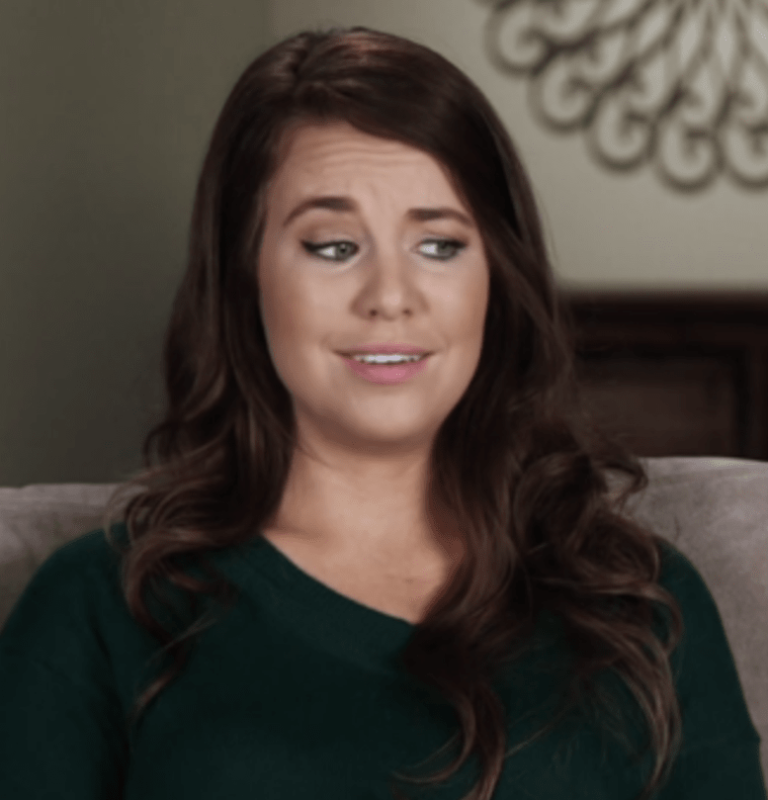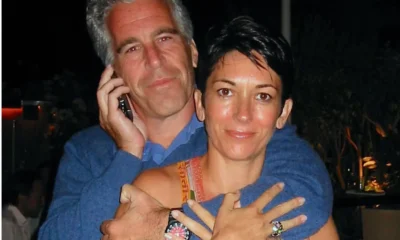Entertainment
Jana Duggar Might Be Avoiding Marriage Because She Took a Vow of “Single … on November 6, 2023 at 11:16 pm The Hollywood Gossip

Despite growing up in a religious community that’s been described as a fertility cult, Jana Duggar is still single and childless as she approaches her 34th birthday.
There’s been a great deal of speculation with regard to why Jana continues to live at home with her parents as her younger siblings leave the nest to start families of their own.
(Women in the Duggars’ community are not permitted to live on their own, otherwise, Jana might be happily residing in an apartment somewhere instead of sharing a bedroom with her youngest sisters.)
Some observers believe that Jana is secretly in love with her best friend, Laura DeMasie.
Jana Duggar on Counting On. With all her family’s nonsense, that must be a facial expression that she makes quite often. (Photo Credit: TLC)
Indeed, homosexuality is so taboo in the Duggars’ bizarre belief system that if Jana were in a relationship with a woman, she would have little choice but to hide it from the world.
The alleged relationship has inspired many impassioned pleas for Jana and Laura to break free and make a life for themselves somewhere far from the small-mindedness of their Arkansas hometown.
But there’s no actual evidence of any romantic connection between the two friends.
Jana Duggar and her friend Laura DeMasie are the topic of much discussion. What is the nature of their relationship? (TLC)
The more likely explanation for Jana’s continued solitude is that she simply made a choice not to marry.
That might mean that she’s just never met the right guy.
Or, like just about everything else in the Duggars’ world, it may have to do with religion.
Yes, many now believe that Jana took a vow to remain single in the days when her family was still being manipulated by the cult leader Bill Gothard.
Cult leader Bill Gothard resigned from his post in disgrace following dozens of sexual assault and harassment allegations. Here he is with Jim Bob Duggar in 2017. (Photo Credit: Getty Images)
Gothard founded the Institute in Basic Life Principles, which formed the basis for many of the Duggars’ bizarre beliefs.
The guru later resigned in disgrace following dozens of sexual harassment allegations, but insiders say his teachings continue to shape Jim Bob’s worldview.
In the recent Amazon documentary Shiny Happy People, Jill Duggar revealed that Jana was selected to work closely with Gothard while she was still in her teens.
Jana Duggar speaks here to the camera and talks about her love life on Counting On. (TLC)
Disturbingly, Jill noted that the decision might have been a result of Gothard’s known preference for blondes.
In her recent memoir, Jill went into greater detail about Gothard’s instructions to unmarried young women.
“We were encouraged not to just sit around waiting for our future mate to show but instead to occupy our time in ways that distracted us from constant thoughts of marriage,” she wrote.
“Mr. Gothard even taught that it was best to make a vow of single service, committing a specific number of years to serving God while single. His teaching,” Jill continued.
Look out, Michelle and Jim Bob! Jill Duggar has come out with a book that exposes just how evil you truly are. (Photo Credit: Amazon)
Earlier this week, that passage sparked an interesting conversation on the r/DuggarsSnark subreddit.
“Do you think Jana has taken a vow of single service?” one user asked in reference to Jill’s remarks about Gothard.
“I think Jana has what she needs. She stays busy at the house, she has Laura and I assume other friends, the greenhouse if that’s still going,” one commenter wrote.
“She seems content with how things are. Being single gives her the freedom to travel to or with all of her siblings.”
Jana Duggar is surrounded here by flowers. What a lovely snapshot. (Photo Credit: Instagram)
“Yes! And a vow of singleness would really help excuse her desire to live an independent life,” another added.
“Nope. As has been discussed here a billion times, she probably just doesn’t like her options so far,” a third chimed in,” a third chimed in.
“At home she has her beautiful garden, her greenhouse, her curtained off section of bedroom and younger sisters to do all the chores (which there really aren’t that many of anymore). Getting married would be a huge step down.”
We might never know for sure why Jana has decided to remain unattached.
But she likely dodged a bullet by refusing to be corralled into an arranged marriage by her overbearing father.
Jana Duggar Might Be Avoiding Marriage Because She Took a Vow of “Single … was originally published on The Hollywood Gossip.
Despite growing up in a religious community that’s been described as a fertility cult, Jana Duggar is still single and …
Jana Duggar Might Be Avoiding Marriage Because She Took a Vow of “Single … was originally published on The Hollywood Gossip.
The Hollywood Gossip Read More
Entertainment
What We Can Learn Inside 50 Cent’s Explosive Diddy Documentary: 5 Reasons You Should Watch

50 Cent’s new Netflix docuseries about Sean “Diddy” Combs is more than a headline-grabbing exposé; it is a meticulous breakdown of how power, celebrity, and silence can collide in the entertainment industry.
Across its episodes, the series traces Diddy’s rise, the allegations that followed him for years, and the shocking footage and testimonies now forcing a wider cultural reckoning.

1. It Chronicles Diddy’s Rise and Fall – And How Power Warps Reality
The docuseries follows Combs from hitmaker and business icon to a figure facing serious criminal conviction and public disgrace, mapping out decades of influence, branding, and behind-the-scenes behavior. Watching that arc shows how money, fame, and industry relationships can shield someone from scrutiny and delay accountability, even as disturbing accusations accumulate.

2. Never-Before-Seen Footage Shows How Narratives Are Managed
Exclusive footage of Diddy in private settings and in the tense days around his legal troubles reveals how carefully celebrity narratives are shaped, even in crisis.
Viewers can learn to question polished statements and recognize that what looks spontaneous in public is often the result of strategy, damage control, and legal calculation.
3. Survivors’ Stories Highlight Patterns of Abuse and Silence
Interviews with alleged victims, former staff, and industry insiders describe patterns of control, fear, and emotional or physical harm that were long whispered about but rarely aired in this detail. Their stories underline how difficult it is to speak out against a powerful figure, teaching viewers why many survivors delay disclosure and why consistent patterns across multiple accounts matter.
4. 50 Cent’s Approach Shows Storytelling as a Tool for Accountability
As executive producer, 50 Cent uses his reputation and platform to push a project that leans into uncomfortable truths rather than protecting industry relationships. The series demonstrates how documentary storytelling can challenge established power structures, elevate marginalized voices, and pressure institutions to respond when traditional systems have failed.
5. The Cultural Backlash Reveals How Society Handles Celebrity Accountability
Reactions to the doc—ranging from people calling it necessary and brave to others dismissing it as a vendetta or smear campaign—expose how emotionally invested audiences can be in defending or condemning a famous figure. Watching that debate unfold helps viewers see how fandom, nostalgia, and bias influence who is believed, and why conversations about “cancel culture” often mask deeper questions about justice and who is considered too powerful to fall.
Entertainment
South Park’s Christmas Episode Delivers the Antichrist

A new Christmas-themed episode of South Park is scheduled to air with a central plot in which Satan is depicted as preparing for the birth of an Antichrist figure. The premise extends a season-long narrative arc that has involved Satan, Donald Trump, and apocalyptic rhetoric, positioning this holiday episode as a culmination of those storylines rather than a stand‑alone concept.
Episode premise and season context
According to published synopses and entertainment coverage, the episode frames the Antichrist as part of a fictional storyline that blends religious symbolism with commentary on politics, media, and cultural fear. This follows earlier Season 28 episodes that introduced ideas about Trump fathering an Antichrist child and tech billionaire Peter Thiel obsessing over prophecy and end‑times narratives. The Christmas setting is presented as a contrast to the darker themes, reflecting the series’ pattern of pairing holiday imagery with controversial subject matter.
Public and political reactions
Coverage notes that some figures connected to Donald Trump’s political orbit have criticized the season’s portrayal of Trump and his allies, describing the show as relying on shock tactics rather than substantive critique. Commentators highlight that these objections are directed more at the depiction of real political figures and the show’s tone than at the specific theology of the Antichrist storyline.
At the time of reporting, there have not been widely reported, detailed statements from major religious leaders focused solely on this Christmas episode, though religion-focused criticism of South Park in general has a long history.
Media and cultural commentary
Entertainment outlets such as The Hollywood Reporter, Entertainment Weekly, Forbes, Slate, and USA Today describe the Antichrist arc as part of South Park’s ongoing use of Trump-era and tech-world politics as material for satire.
Viewer guidance and content advisory
South Park is rated TV‑MA and is intended for adult audiences due to strong language, explicit themes, and frequent use of religious and political satire. Viewers who are sensitive to depictions of Satan, the Antichrist, or parodies involving real political figures may find this episode particularly objectionable, while others may view it as consistent with the show’s long‑running approach to controversial topics. As with previous episodes, individual responses are likely to vary widely, and the episode is best understood as part of an ongoing satirical series rather than a factual or theological statement.
Entertainment
Sydney Sweeney Finally Confronts the Plastic Surgery Rumors

Sydney Sweeney has decided she is finished watching strangers on the internet treat her face like a forensic project. After years of side‑by‑side screenshots, “then vs now” TikToks, and long comment threads wondering what work she has supposedly had done, the actor is now addressing the plastic surgery rumors directly—and using them to say something larger about how women are looked at in Hollywood and online.

Growing Up on Camera vs. “Before and After” Culture
Sweeney points out that people are often mistaking normal changes for procedures: she grew up on camera, her roles now come with big‑budget glam teams, and her body has shifted as she has trained, aged, and worked nonstop. Yet every new red‑carpet photo gets folded into a narrative that assumes surgeons, not time, are responsible. Rather than walking through a checklist of what is “real,” she emphasizes how bizarre it is that internet detectives comb through pores, noses, and jawlines as if they are owed an explanation for every contour of a woman’s face.
The Real Problem Isn’t Her Face
By speaking up, Sweeney is redirecting the conversation away from her features and toward the culture that obsesses over them.
She argues that the real issue isn’t whether an actress has had work done, but why audiences feel so entitled to dissect her body as public property in the first place.
For her, the constant speculation is less about curiosity and more about control—another way to tell women what they should look like and punish them when they do not fit. In calling out that dynamic, Sweeney isn’t just defending herself; she is forcing fans and followers to ask why tearing apart someone else’s appearance has become such a popular form of entertainment.

 Entertainment2 weeks ago
Entertainment2 weeks agoWicked Sequel Disappoints Fans: Audience Verdict on For Good

 News3 weeks ago
News3 weeks agoYolanda Adams Questions Traditional Views on God’s Gender, Audience Reacts

 Entertainment2 weeks ago
Entertainment2 weeks agoAriana & Cynthia Say They’re in a ‘Non‑Demi Curious, Semi‑Binary’ Relationship… WTF Does That Even Mean?

 News3 weeks ago
News3 weeks agoEpstein Files to Be Declassified After Trump Order

 News4 weeks ago
News4 weeks agoTrump Throws Epstein Files at Clinton’s Door

 Entertainment4 weeks ago
Entertainment4 weeks agoAriana Grande’s Red Carpet: When Fans Forget Boundaries

 Entertainment4 weeks ago
Entertainment4 weeks agoKim Kardashian Reportedly Scammed by Psychic Before Failing Bar Exam

 Entertainment3 weeks ago
Entertainment3 weeks agoHollywood’s Kiss or Miss Policy: Why Saying No Got Neal McDonough Blackballed


























